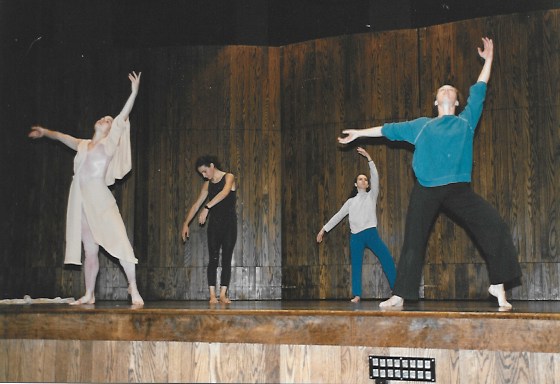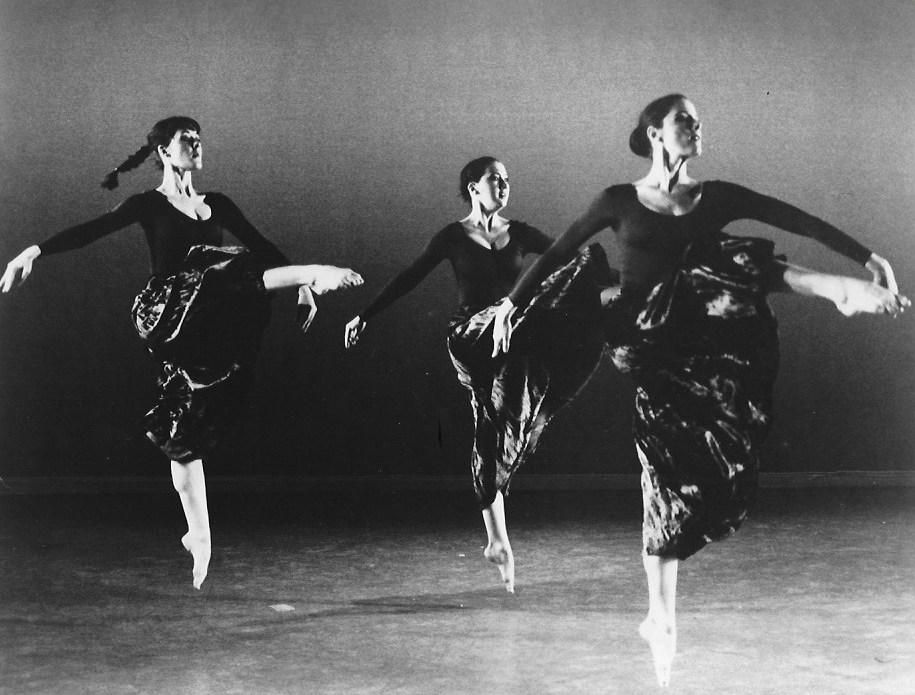We were thrilled when our publisher, A.R.E. Publishing Inc., arranged for Avodah to perform and lead a workshop at CAJE, a conference of Jewish educators. Founded in 1976, The Coalition for the Alternatives in Jewish Education held its first conference with about 500 in attendance at Brown University. By the time we appeared at the 15thConference at Ohio State University in Columbus, Ohio there were 2000 in attendance and the name had changed to The Coalition for the Advancement of Jewish Education. The full company of four dancers (Kezia Gleckman Hayman, Deborah Hanna, Susan Freeman and Elizabeth McPherson) participated in a concert that combined a lecture demonstration as well as a performance. When Susan and I were not leading or attending a session we had fun being at the A.R.E. booth and signing copies of our book.
It was very special to have the two owners of A.R.E. so actively involved in promoting our book and I was so glad to find the following two pictures in Avodah’s scrapbook.


Avodah had recently added a new piece to the repertory called Sisters which I will describe in detail in a later blog. For the CAJE conference we used excerpts from the piece as part of the lecture demonstration


The conference built a lot of momentum for Avodah with Jewish educators and we soon found ourselves leading regular sessions in dance midrash, particularly in Reform Congregations throughout the New York area, for the next 12 years. I continued to attend CAJE conferences over the next several years and was often invited to do teacher-training programs in different parts of the country.
Much to our surprise and delight, Torah in Motion: Creating Dance Midrash received quite a few reviews in different publications. In a review in Compass, a publication of the Union of American Hebrew Congregations, Rabbi Nancy Weiner wrote,” What a revolutionary concept it is to blend proud academic analysis with the vibrancy of movement” (Vol. 13, No. 3, Spring– Summer 1991). A review in the Sacred Dance Guild Journal in the Fall of 1990 pointed out that “this book not only contains introductory material to help the reader/teacher get into what it is about, but supplies beginnings for the creative teacher/dancer, on many sections of the Bible.
I found it interesting that the book was finding an audience with dancers in the Christian community. In a publication in 1992 called Phoenix Rising, which celebrated the Arts in Religion and Community, Kay Troxell, who had been active in sacred dance for 20 years, wrote:
Our dances so often reflect the New Testament that we miss the many rich opportunities offered in these books of the Torah (the Christians’ Old Testament). Moving from words to movement can bring a whole new perspective to the original words and this is what Torah in Motion does. The fact that it is designed to be suitable for children as well as adults, dancers, would-be-dancers, and those at all levels of experience, makes this book valuable to persons wanting to find dance in biblical verses and wanting to stretch their creativity as well as their bodies.
Dance Magazine in the February 1991 issue had a nice mention of the book. And then in 1999, Attitude: The Dancers’ Magazine did a very informative piece on the book:
..the movement improvisations of Torah in Motion are focused on community without a barrier or division of spectator and performer. Here everyone is a participant: a thinking body if you will, filled with both movement possibilities and thoughts of contemporary relevance. Dance Midrash has wide application possibilities in summer camps, senior citizen homes, settlement houses, day camps and various adult education settings and schools.
In 2000 when A.R.E. decided not to reprint the book, Susan and I explored the possibility of making it available “on demand” through a company called “E-rights.” A.R.E gave us permission to use the cover they had designed, and the Photographer of the photos in the book, Tom Brazil, also gave us permission to use them in the “on-demand” version. In 2014 the book became available through Open Road Media and may be purchased on Amazon. The almost 30-year journey of the book is fun for me to remember and I am delighted it is still available and being used.
[print_link]
















